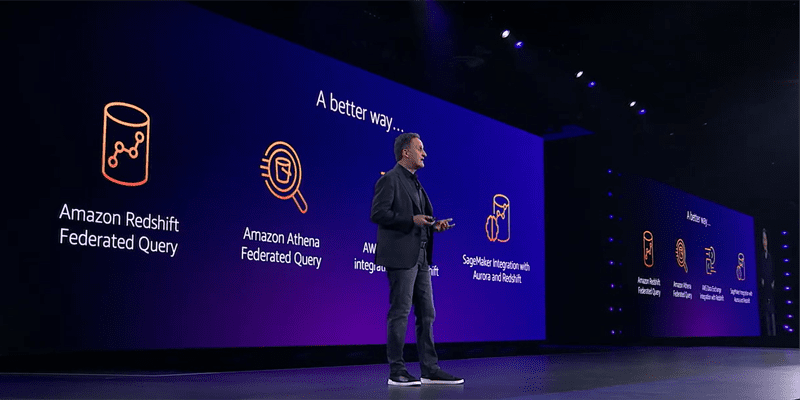New Sustainability Commitments, Product and Feature Announcements at re:Invent

AWS re:Invent is now in full swing. The conference—this year hosted in Las Vegas—is a five-day affair featuring keynote speakers and leadership sessions from AWS leaders and partners, covering topics from new product and feature announcements to the cutting edge of cloud computing technology and how it can help businesses and organizations.
The conference kicked off yesterday with a two-hour keynote address from Amazon Web Services CEO Adam Selipsky. Here are the big highlights in case you missed it.
Sustainability takes a front row seat
Governments and corporations around the world have made big pushes for sustainability this year, and that’s no different for AWS. Selipsky highlighted green strides Amazon has made as a whole—like being on track to reach its goal of running on 100 percent renewable energy five years ahead of schedule—as well as announcing some new goals like being water-positive by 2030.
Many data center operators don’t make water consumption numbers public, much less share measurable goals about reducing water usage. But on Tuesday, Selipsky announced AWS is committing to return more water than it uses to the communities where it operates.
Water usage at data centers sometimes gets overlooked thanks to the massive amounts of electricity they consume (somewhere between 220 and 320 terawatt hours (TWh) in 2021 for data centers around the globe). But data centers require lots of water, mostly for cooling, with data centers in the US using about 1.7 billion liters of water a day.
Being the largest cloud provider by market share in the world, AWS’s commitment is a big deal.
Serverless and zero-ETL are big focuses
The rest of Selipsky’s keynote covered four main areas:
- Right tools
- Integration
- Governance
- Insights
Some themes remained consistent across these areas, like the general move toward serverless computing throughout the AWS ecosystem. For example, all AWS analytics tools now offer a serverless configuration, with AWS OpenSearch Service being the latest addition, announced yesterday.
In fact, it’s probably more accurate to say that AWS tools are trending towards a less manual experience overall. That means customers will have less to worry about in terms of managing infrastructure, writing code, and making queries.
For example, Selipsky spent a good amount of time talking about the cloud provider’s plans for a zero-ETL future, eliminating the need for custom coding ETL pipelines and ultimately democratizing access to data insights. Amazon Aurora—the fastest-growing product AWS offers, per Selipsky—now offers a zero-ETL integration with Amazon Redshift.
Amazon DataZone (a new product announced yesterday—more on that in a bit) uses machine learning (ML) so customers can easily uncover insights from their data using business terms. Similarly, Amazon QuickSight—the business intelligence offering from AWS—now supports ML-powered search, eliminating the need to write SQL to query data.
> How to Hire an AWS Developer in a Wild Labor Market
New products and feature announcements
AWS is known for its extensive product lineup, and yesterday’s keynote saw the announcement of several new products as well as updated or new features to existing products.
First, products. Here are the new products Adam Selipsky announced in his November 29th keynote address:
- Amazon DataZone. A data management service that allows for secure sharing and analysis of data while protecting consumer privacy.
- Amazon Security Lake. A data lake product that pulls together data from cloud and on-premises sources at petabyte scale. Security Lake conforms to the Open Cybersecurity Schema Framework (OCSF) open standard and lets users query data with both AWS analytics tools and third party tools like Splunk.
- AWS SimSpace Weaver. A powerful new product for running massive spatial simulations without having to manage infrastructure, powered by investments AWS has made in high performance computing (HPC) technology.
- Amazon One. More relevant for retail businesses, Amazon One is a new payment method that uses—wait for it—your palm. No, it’s not an RFID chip that you implant in your hand—it’s a new technology that uses biometrics to scan your palm for payment.
Beyond new products, there were also plenty of feature updates and new feature announcements:
- AWS OpenSearch Service is now available in serverless
- Amazon Aurora now supports a zero-ETL integration with Amazon Redshift
- Amazon Redshift now supports integration with Apache Spark
- Amazon QuickSight now supports data query with natural language processing—no need to write SQL queries. It also includes ML-powered forecasting with the ability to ask “why” questions of data.
- GuardDuty has a new security feature—container runtime threat detection
- EC2 Hpc6id instances are now generally available
- Amazon Connect has three new features: ML-driven forecasting, a conversational analytics and quality management feature for agents called Contact Lens, and the addition of how-to guides to Agent Workspace
More to come
Overall, many of these announcements underscored a push for increasing the interoperability of AWS products while also improving security and making products more accessible to non-technical contributors.
Re:Invent is just getting started, but there have already been some fascinating talks. Check back on our blog for more recaps of the most exciting keynote addresses from this week.

Related articles
Discover Your Cloud’s Potential with Nerdly Select: A Journey into Well-Architected Framework Reviews
Picture this: you're leading your business through a constantly changing world, facing challenges and chances for success. With technology evolving at lightning speed, the need for expert guidance becomes even more crucial. Having a reliable team of cloud experts by...
Improving Software Quality with Nerdly Select: A Closer Look at Our QA as a Service Pod
Nowadays, making sure your software works perfectly is more important than ever. Minor glitches or bugs can significantly disrupt user experience, leading to customer dissatisfaction and potential revenue loss. Understanding the challenges businesses face in achieving...
Revolutionize Your Cloud Management With NerdRabbit’s AWS Control Tower Configuration Pod
Managing cloud infrastructure can feel overwhelming for most people. When it comes to cloud services, AWS Control Tower stands as a solution, helping organizations easily manage their cloud setup in a secure and efficient way. It's a key tool for anyone using AWS,...






